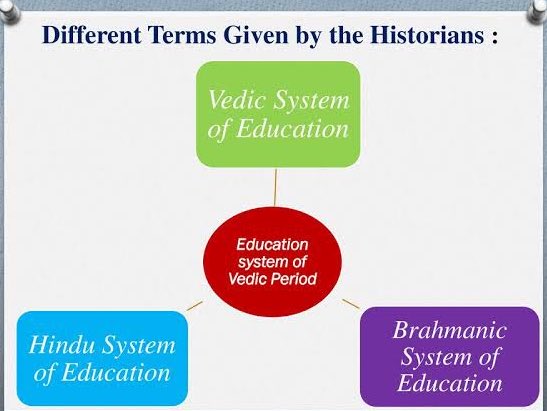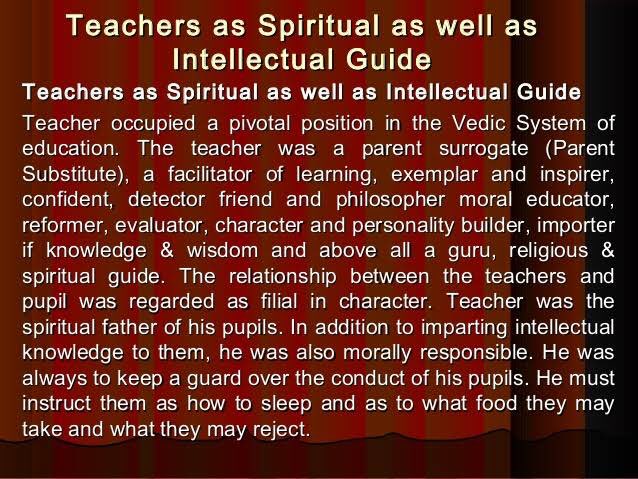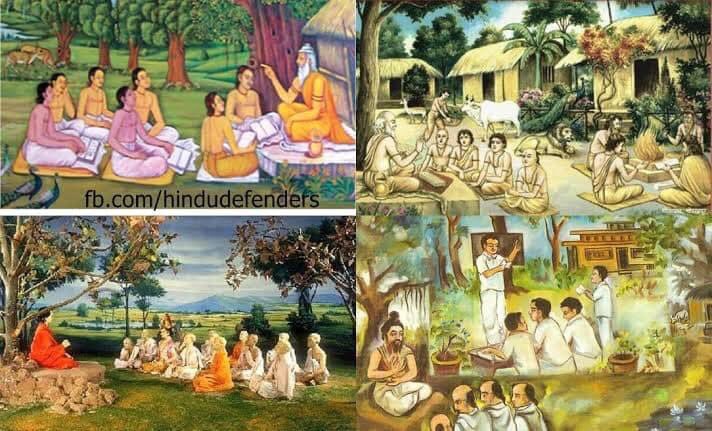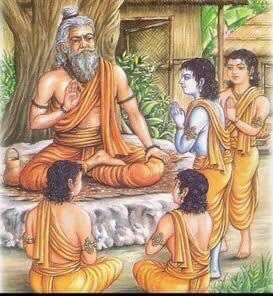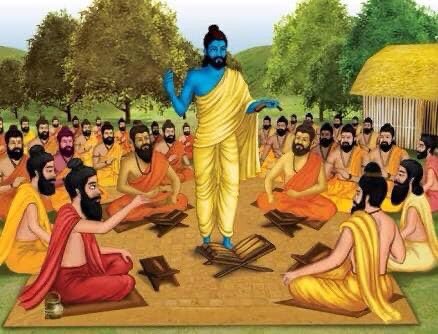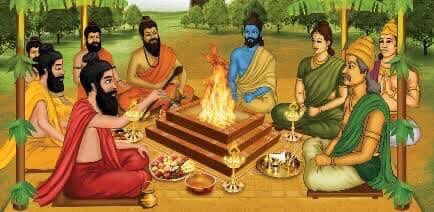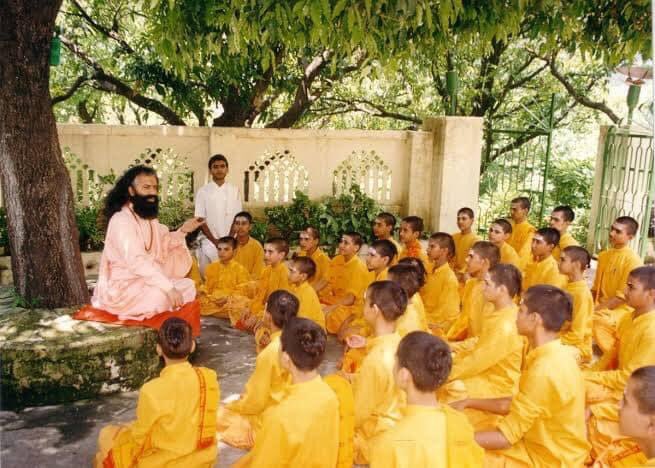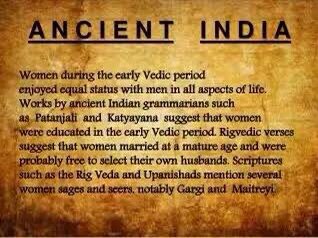A). Education system during vedic era.
After reading this article you will learn about the Education system during Vedic Period in India.
1. Introduction to Vedic Period in India:
The ancient India had their distinctive culture and civilization over the thousands of years.
After reading this article you will learn about the Education system during Vedic Period in India.
1. Introduction to Vedic Period in India:
The ancient India had their distinctive culture and civilization over the thousands of years.
B). In d past d great saints hve played a decisive role in shaping&molding d ancient heritage.D ancient Indian education emerged frm d Vedas.D Vedas r d best expression of an enlightened culture&have contained within themselves d seeds&sources of Hindu thoughts&practices.
C). The Vedas have laid the foundation upon which the entire Hindu culture and civilization has been building up through the ages. Veda means knowledge. During this period education was divided into two kinds of knowledge-this worldly and other worldly.
D). This worldly education dealt with the social aspect, whereas, the other worldly education was related to intellectual pursuits for achieving salvation. However, the greater emphasis was laid on the latter because education was regarded as a means of free from life bondage.
E).
2). System of Admission during Vedic Period in India:
The system of education which was prevalent was altogether different from the present system of education. Student life in Vedic education began with upanayana, when the student goes to his chosen teacher called Acharya.
2). System of Admission during Vedic Period in India:
The system of education which was prevalent was altogether different from the present system of education. Student life in Vedic education began with upanayana, when the student goes to his chosen teacher called Acharya.
F).
D place of learning was called Gurukula. D ceremony was performed for3days. After d ceremony of upanayana d pupil emerges as a dwija or twice born.This upanayana ceremony,unfolds his mind&soul.After this ceremony,d pupil was called as a Brahmachari,a new&changed individual,
D place of learning was called Gurukula. D ceremony was performed for3days. After d ceremony of upanayana d pupil emerges as a dwija or twice born.This upanayana ceremony,unfolds his mind&soul.After this ceremony,d pupil was called as a Brahmachari,a new&changed individual,
G). both internally&externally,from which he began his student life.
Learning was almost monopolized by the Brahmins. As time passed on, D other castes were also entitled to receive education.
Learning was almost monopolized by the Brahmins. As time passed on, D other castes were also entitled to receive education.
H). The home of the teacher or Guru was the centre of learning in Vedic period which was situated in natural surroundings, not artificially constituted. It was functioning in solitude and silence. The age limit4upanayan ceremony was 8yrs,11yrs&12yrs, respectively.
I).
3. Aims of Education during Vedic Period in India:
D following r d aims of education in vedic period:
i. The aim of Vedic education was to realize the supreme&achieve Supreme Consciousness (Brahman).
ii. Inculcation of a spirit of piety&righteousness was d aim of education.
3. Aims of Education during Vedic Period in India:
D following r d aims of education in vedic period:
i. The aim of Vedic education was to realize the supreme&achieve Supreme Consciousness (Brahman).
ii. Inculcation of a spirit of piety&righteousness was d aim of education.
J). iii.Preservation&spread of ancient culture was1of d aims of ancient educational system.
iv.D chief aim was2unfold d spiritual&moral powers of d individual during VedicPeriod.
v.D objectives of educationWere perfection of d physical,mental&intellectual personality of d pupils
iv.D chief aim was2unfold d spiritual&moral powers of d individual during VedicPeriod.
v.D objectives of educationWere perfection of d physical,mental&intellectual personality of d pupils
K).vi. Formation of good and moral character was also another aim of Vedic education.
vii. Inculcation of social and civic duties was one of the aims in Vedic period which was necessary for a better future life.
vii. Inculcation of social and civic duties was one of the aims in Vedic period which was necessary for a better future life.
L). viii. For the development of vocational efficiency healthy, positive attitude and dignity of labour were fostered in pupils during Vedic period.
M). 4. Vedic Period in India and Curriculum:
The curriculum during Vedic period, was dominated by the study of the Vedas and Vedic literature, spiritual and moral lessons. The other subjects of teachings were philosophy, grammar, language, literature, astrology and logic.
The curriculum during Vedic period, was dominated by the study of the Vedas and Vedic literature, spiritual and moral lessons. The other subjects of teachings were philosophy, grammar, language, literature, astrology and logic.
N). Physical education was also included in d curriculum.Students had2learn riding,archery,wrestling, hunting,jumping,dancing etc.Some professional&technical subjects like Ayurveda or Ciktsavidya (medicine&surgery),astronomy, mathematics,Arthashastra etc.
O). were given due importance in the curriculum.
5. Vedic Period in India and Methods of Teaching:
There were mainly three steps of learning according to Vedic system. Sravana, the first step meant listening towards the texts as uttered by the teacher.
5. Vedic Period in India and Methods of Teaching:
There were mainly three steps of learning according to Vedic system. Sravana, the first step meant listening towards the texts as uttered by the teacher.
P). By this method of education, knowledge was conserved and transmitted to the oncoming generation. The second step was Manana i.e. to internalize or to assimilate what was given to the pupil.
It is a process of deliberation and reflection on the topic.
It is a process of deliberation and reflection on the topic.
Q). The third step was Nididhyasana (Meditation) by which truth is realised and attained. It was considered indispensable for the realization of the Supreme Reality.
The ancient system of teaching was listening (Shruti). Perception was the direct method of learning.
The ancient system of teaching was listening (Shruti). Perception was the direct method of learning.
R). Lecture, dialogue, debate, discussion, question-answer, sightseeing etc. were adopted as the methods of teaching. On the whole both intuitive and empirical methods, both Yogic and Scientific methods were adopted for acquisition of knowledge and skills.
S).
6. Conclusion:
Lastly we may conclude that the Vedic education being mostly spiritual, liberal and contemplative in nature, was meant for all who were really interested, capable and dedicated and were in search of the highest truth and supreme knowledge.
6. Conclusion:
Lastly we may conclude that the Vedic education being mostly spiritual, liberal and contemplative in nature, was meant for all who were really interested, capable and dedicated and were in search of the highest truth and supreme knowledge.
T). Education was free of cost&d students led an exemplary life in VedicSystem of education.D teacher-taught relationship was very cordial&just like d father-son relationship during VedicPeriod. Education was not based on Gender, caste,creed,colour or religion.
#JaiShreeKrishna.
#JaiShreeKrishna.

 Read on Twitter
Read on Twitter